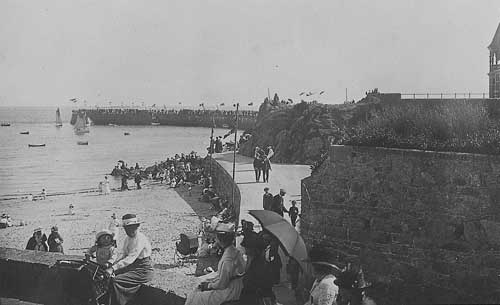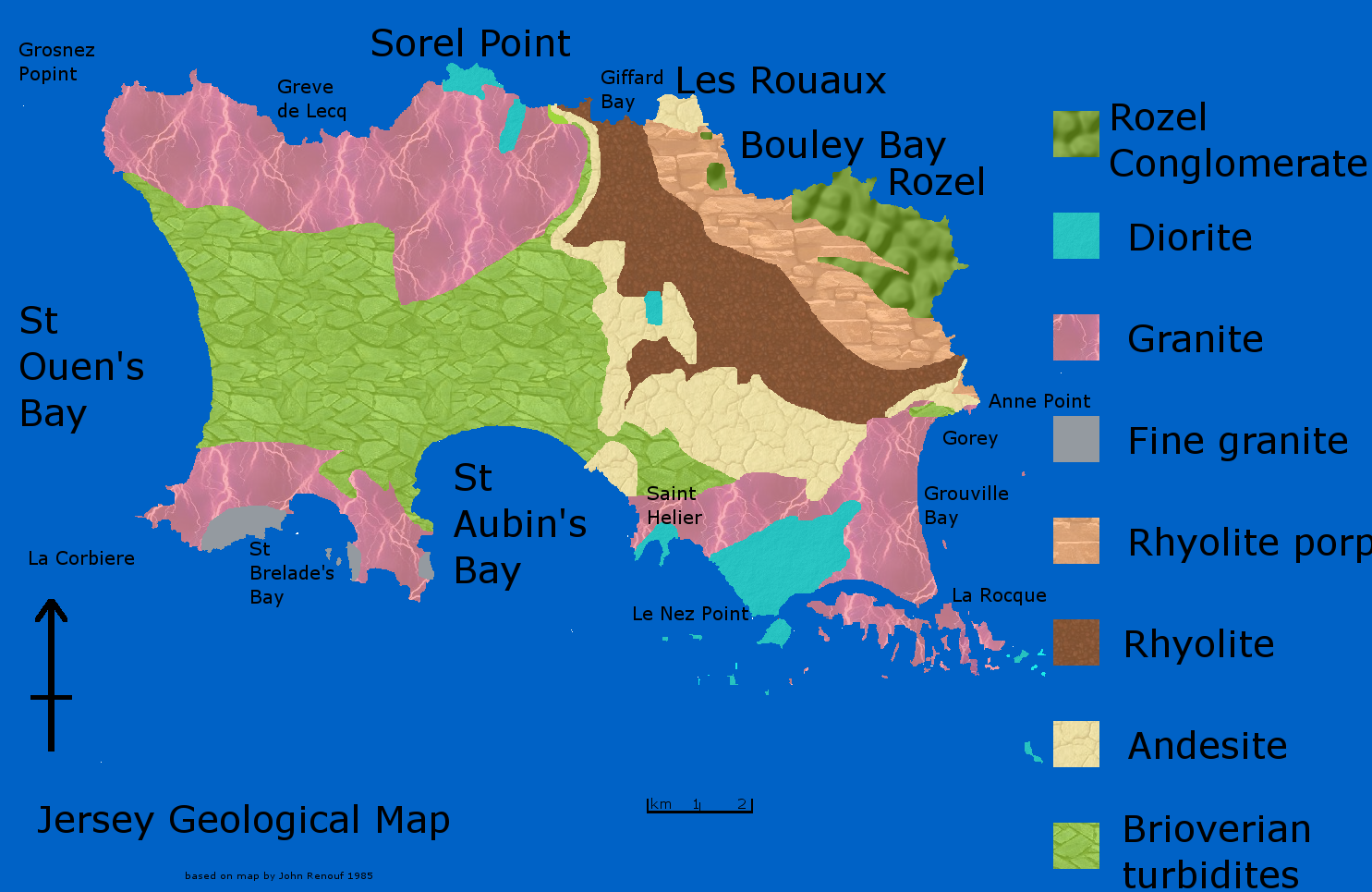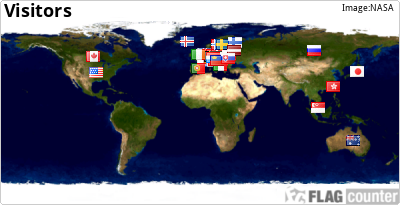La Rocque, at the south-east corner of the island, was once one of only two centres of population on the east of Jersey, the other being Gorey. In-between lay only farmsteads. Today the whole coastline from St Helier to Gorey is developed, with very few open spaces. Many historical structures are visible from the pier, including ‘Seymour Tower’ that was built out to sea during the battle of Jersey. At La Rocque the road meets the coast, overlooking the small harbour. This was a refuge for fishing vessels from the Middle Ages, although no jetty was built until the 1800s.
A regatta in the Edwardian period by La Rocque Pier:

The geology of Jersey is characterised by the Late Proterozoic Brioverian volcanics, the Cadomian Orogeny, and only small signs of later deposits from the Cambrian and Quaternary periods. Millions of years ago Grouville was an area near a volcano. The lava which spewed forth formed the dark, mauve coloured rocks seen in Jersey. From this seemingly innocuous detail, geologists can say for sure that Jersey was volcanic at one time. By looking at the different ages of the rocks, they can determine the basic foundations of the island.
Jersey also lies near a stress point of a tectonic plate. Although distant from the nearest plate boundary, which is the Mid-Atlantic Ridge, earthquakes - which is why Jersey can experience small tremors.
Around the coast of Jersey isn’t just the modern coastline, but you have fragmented remnants of much older coastlines which is preserved on Jersey’s coast. For long periods, it would not have been an isolated island, but part of a broad landmass extending from the modern coast of France across to where a deep river flowed through the centre of the modern channel. This plain was not flat and featureless, but dissected by deep rivers and now-submerged uplands. Due to Jersey being a high land mass and the build up of volcanic lava, Jersey became a high point of land and ancient hunter-gatherer groups would always have tracked in on Jersey as a high point, from where they see out over the rich landscapes of the channel river plain.
Jersey would have slowly disconnected from mainland and would have formed the island you are standing on today. The area of ‘Seymour’ is a submerged ice-age landscape, meaning that Grouville’s granite and other rocks here would have been partly eroded during the melting of the ice-age.
Granite is an igneous rock, igneous rocks form through the crystallisation of magma (molten rock). They are referred to as ‘plutonic intrusives’ when they form deep below the Earth’s surface, ‘volcanic intrusives’ when emplaced in the shallow subsurface, and ‘volcanic extrusives’ when coming from a volcano and deposited on the surface. The size of the crystals in the granite is related to the rate of cooling (larger crystals form when cooling is very slow). Unlike sedimentary rocks, igneous rocks do not contain any fossils.
Grouville’s most common rock type is Granite: a hard, crystalline rock which is made up of three minerals: quartz, feldspar and mica. Granite originates 300 million years ago in the Carboniferous Period, a time of active mountain-building as the supercontinent Pangaea came together. The rock can be volcanic or plutonic, and can be a variety of different colours. Jersey’s geology is mainly characterised by volcanoes, but the majority of the granite rocks you can see at Grouville are plutonic.
Most common rock types of Jersey:

Lots of the plutonic granite rocks have unusual lines running through them (lines that are commonly lighter than the original rock). These lines are names ‘veins’ and are usually formed due to irregular formation of crystals.
The Granite stones you can see around you are weathered and eroded constantly by many different methods. One of the large contributors of erosion is the sea, in which Grouville’s extreme tides cause the rocks to slowly, very slowly change shape over time. Jersey may be a small island, but can boast some of the biggest tides in the world. When it recedes, the immense body of water that surrounding us seems to melt into the horizon, only to surge back to shore with alarming speed. This is because you have a huge see-saw of water, with high tide at one end and low tide at the other. This massive bulge of water moves backwards and forwards twice each day. When it arrives in our corner of the English Channel this bulge of water really hasn’t got anywhere to go, thus creating the extreme tides seen at Grouville. In fact, Jersey almost expands 1/3 every time the sea retreats!
If you are injured/disabled you can complete this cache by not being on the bunker.
QUESTIONS!
1) Look at the granite rocks around you. Why are some rocks smooth and others appear jagged? Describe how they have become that way.
2) The granite rocks can have a variety of colours. What different colours you can see, and why do you think they vary in colour?
3) Low/medium tide option: why does the beach you can see ahead of you have 'channels.' (bits of low lying land, between the rocks, often with water in them).
High tide option: why are the waves you can see relatively small (compared to most of Jersey)?
4) Look out to sea about 3 miles. What geological feature stops Seymour Tower from sinking?
5) (Optional) Please take a photo of you or your GPS device.
Please email you answers via the message centre!!! You can log your find before confirmation - if there is a problem we can contact you!
Do not include answers in your final log.
Please mention the weather and tidal conditions in your log whilst you were completing this earthcache.

Congratulations to Fauvic for FTF